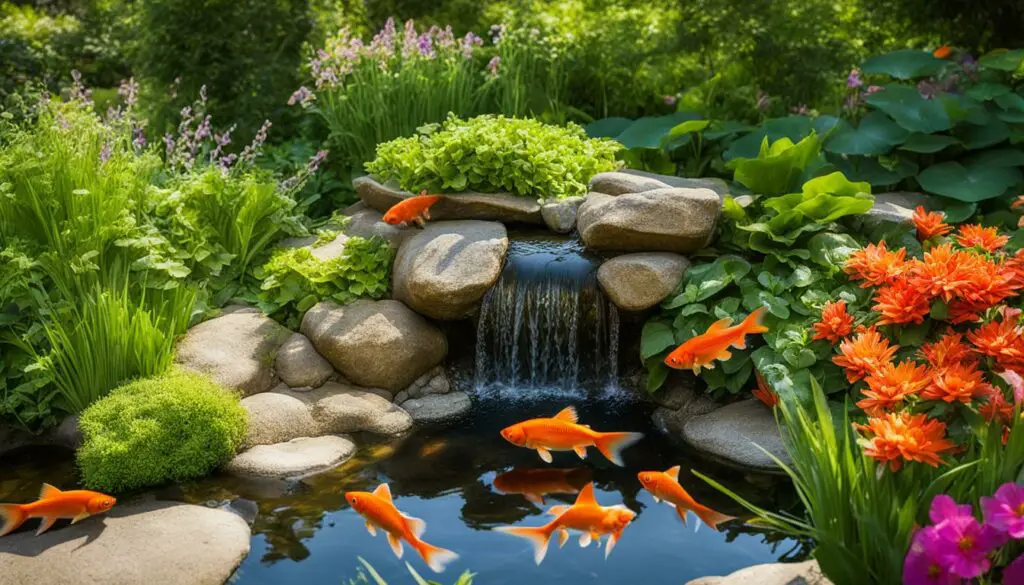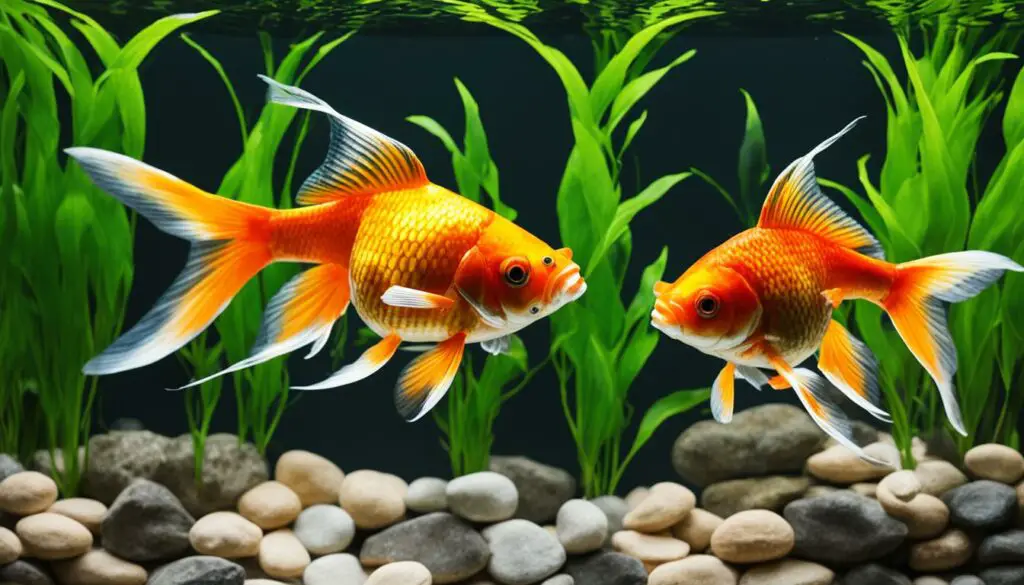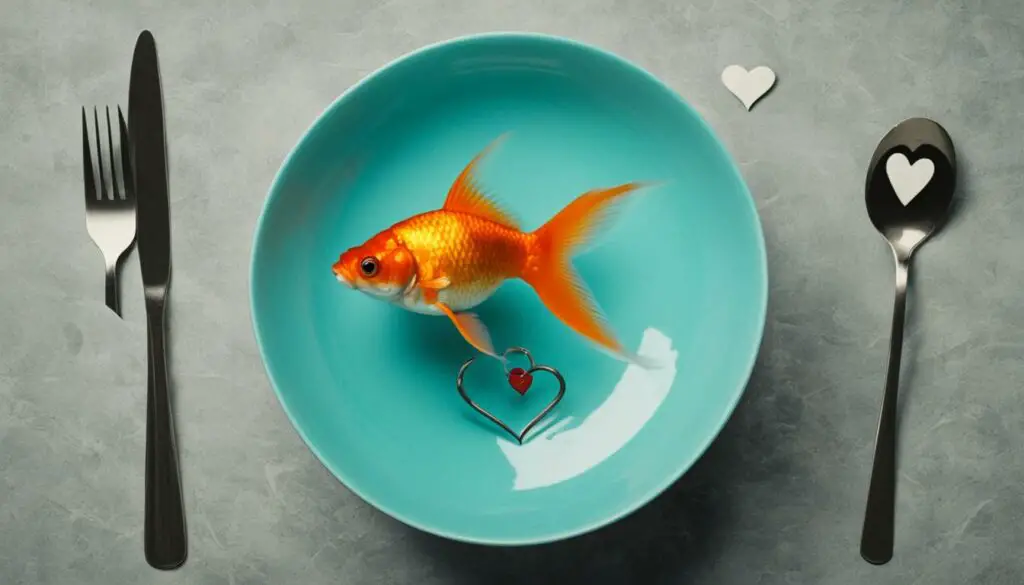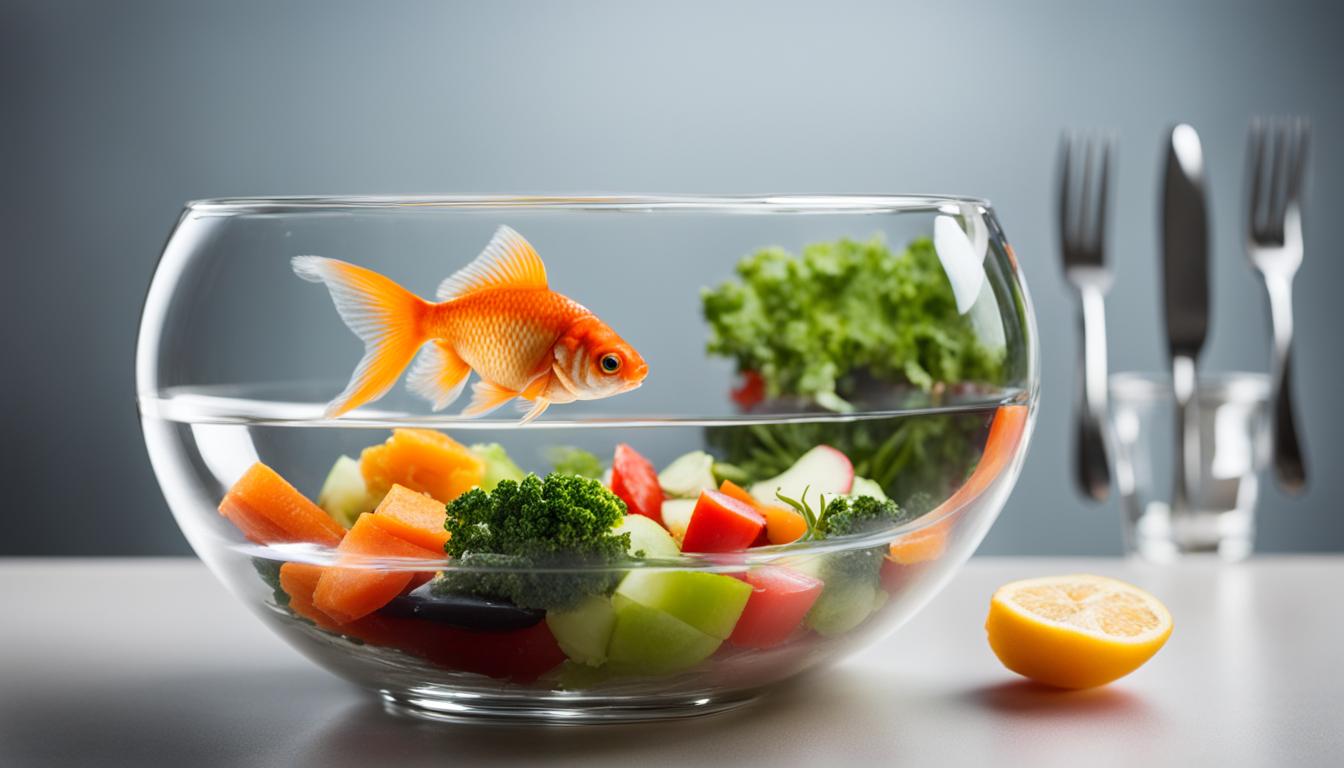Last Updated on 1 year by admin
Goldfish are beloved aquatic creatures commonly kept as pets in aquariums or outdoor ponds. But have you ever wondered if they are edible? In this article, we will explore whether goldfish can be consumed as food, the taste and texture of goldfish, and the potential health risks associated with eating them. Let’s dive in!
Key Takeaways:
- Goldfish are not typically eaten as food, despite their name.
- The taste and texture of goldfish are often described as muddy, fishy, and unappetizing.
- Goldfish can carry harmful bacteria and parasites, posing health risks to those who consume them.
- There are better culinary options available, such as trout, salmon, tilapia, and tuna.
- Goldfish are best enjoyed as pets, providing relaxation, companionship, and educational benefits.
Goldfish as Pets or Food: A Common Misconception

Many people mistakenly believe that goldfish are best kept in an aquarium, but the truth is, they require ample space to grow and thrive. While it’s possible to consider goldfish as food, they are primarily cherished as pets due to their beauty and unique characteristics. Keeping goldfish in a backyard pond is actually preferred, as it provides a larger and more varied habitat, better oxygenation, and high-quality water.
Goldfish are intelligent and interactive pets. They can anticipate feeding times and even recognize their owners, making them a delight to interact with. Plus, their vibrant colors and graceful movements provide a calming and visually appealing experience.
Proper care for your goldfish can lead to a long and joyful life. Despite their delicate appearance, goldfish are surprisingly low-maintenance pets. With the right setup and regular maintenance, they can thrive in a well-designed backyard pond.
Why Choose a Backyard Pond for Your Goldfish?
A backyard pond offers several advantages for goldfish compared to a simple aquarium:
- Ample Space: Goldfish require space to swim and explore. A backyard pond provides a larger and more natural environment, allowing your goldfish to grow and thrive.
- Improved Habitat: Backyard ponds offer a more varied habitat, including plants, rocks, and natural elements. These elements provide hiding spots and areas for goldfish to play and interact.
- Better Oxygenation: Ponds typically have better oxygenation due to the presence of aquatic plants and natural water movement. This promotes the overall health and well-being of your goldfish.
- High-Quality Water: Ponds can accommodate larger filtration systems, ensuring cleaner and healthier water for your goldfish. This helps maintain their overall health and reduces the risk of diseases.
With a well-designed backyard pond, you can create a beautiful and tranquil environment for your goldfish, allowing them to thrive as pets.
Goldfish are a popular choice for beginner pet owners due to their vibrant colors and ease of care. Keeping them in a backyard pond provides them with the space and environment they need to live a happy and healthy life. Remember, goldfish are pets, not food.
A Brief History of Goldfish

Goldfish have a fascinating history that spans centuries and continents. They originated from China and were initially bred as a food source. However, as time went on, goldfish gained popularity as ornamental aquarium pets in Europe and the United States.
In China, goldfish were first domesticated during the Tang Dynasty (618-907 AD). At that time, they were primarily raised for their meat. Goldfish farming techniques were developed and perfected, with different varieties and colors emerging over time.
During the Song Dynasty (960-1279 AD), goldfish caught the attention of the elite class, who kept them in elaborate ponds and gardens. Goldfish were seen as a status symbol and a representation of wealth and prosperity.
Goldfish made their way to Europe in the 17th century, where they quickly gained popularity among affluent families. They were prized for their vibrant colors and graceful swimming patterns. Goldfish breeding programs were established, and new varieties were continuously developed.
In the United States, goldfish first arrived in the late 19th century. The U.S. Commission of Fish and Fisheries played a significant role in promoting goldfish as pets by providing them for free. This contributed to the increasing popularity of goldfish as household pets.
A particularly important development in goldfish history occurred in Martinsville, Indiana. It became the hub of goldfish farming in the United States and was home to the largest goldfish farm in the country.
Goldfish also have a connection to Buddhism, where they are considered sacred animals. They were released into “mercy ponds” by Buddhist monks as a symbolic act of compassion and good luck.
Today, goldfish are cherished pets in households worldwide. They are known for their beauty, calm nature, and the joy they bring to their owners’ lives. Additionally, goldfish are often showcased and awarded prizes at county fairs, further highlighting their cultural significance.
Key Points:
- Goldfish originated from China and were originally bred as a food source.
- They gained popularity as ornamental pets in Europe and the United States.
- Goldfish are considered sacred animals in Buddhism and are released into “mercy ponds” for good luck.
- Goldfish farming became prevalent in Martinsville, Indiana, where the largest goldfish farm in the United States was established.
Exploring the history of goldfish provides valuable insights into their cultural significance and the journey they have taken from being a source of food to beloved pets. Their story exemplifies the profound impact that humans can have on the evolution and appreciation of different animal species.
| Goldfish in China | Goldfish as Pets in Europe and the United States |
|---|---|
| Originated as a food source | Became popular among affluent families |
| Developed goldfish farming techniques | Prized for their vibrant colors and graceful swimming patterns |
| Symbolic significance in Buddhism | Promoted by the U.S. Commission of Fish and Fisheries |
The Taste of Goldfish and Why They Are Not Ideal for Eating

When it comes to culinary choices, goldfish may not be the first option that comes to mind. While it is technically possible to eat goldfish, there are several reasons why they are not considered ideal for consumption.
Goldfish taste like the food they eat. The primary diet of goldfish consists of fish flakes and pellets, which often contain unappetizing ingredients. As a result, the taste of goldfish is not particularly pleasant, even in the case of wild-caught specimens. Many people describe the flavor as muddy and unpleasant.
In addition to the taste, the small size and bony nature of goldfish pose challenges for extracting a substantial amount of meat. The effort required to remove the bones outweighs the potential reward in terms of taste or yield. Goldfish simply do not offer the same level of culinary satisfaction as other fish species.
Furthermore, consuming goldfish carries potential health risks. Goldfish can carry harmful bacteria and parasites, which can pose a threat to human health. Cooking or preparing the fish may not eliminate these risks entirely, making it an unwise choice for consumption.
Reasons Not to Eat Goldfish:
- Unpleasant taste resulting from their diet
- Small size and bony structure
- Potential health risks due to bacteria and parasites
Considering the taste, texture, and potential health hazards associated with consuming goldfish, it is advisable to explore other fish options that provide better taste, texture, and safety. Goldfish are best appreciated as beloved pets rather than consumed as food.
| Taste | Texture | Health Risks |
|---|---|---|
| Muddy and unpleasant | Small and bony | Harmful bacteria and parasites |
Goldfish Swallowing and Health Risks

Goldfish swallowing, a popular dare or bar trick, involves consuming live goldfish. However, this seemingly harmless activity can have serious health consequences. Goldfish can carry harmful parasites and bacteria, including fish tuberculosis, which can be transmitted to humans even when the fish is cooked. Engaging in goldfish swallowing is not only cruel to the fish but also potentially harmful to the person consuming them.
When live goldfish are swallowed, they can cause damage to the digestive system and pose a choking hazard. In addition, the bacteria and parasites carried by goldfish can lead to infections, gastrointestinal issues, and other health problems for those who partake in this activity.
“Goldfish swallowing may seem like a harmless game, but it can have serious health consequences. Consuming live fish carries the risk of contracting harmful bacteria and parasites.”
It is strongly advised against participating in or encouraging goldfish swallowing. Not only does it pose significant health risks, but it also goes against ethical considerations. Goldfish are meant to be pets and sources of joy, not objects to be consumed for entertainment purposes.
| Health Risks of Goldfish Swallowing | Consequences |
|---|---|
| Consuming live goldfish | Digestive system damage, choking hazard |
| Bacteria and parasites | Infections, gastrointestinal issues |
Instead, let’s appreciate goldfish for their beauty, companionship, and the joy they bring as pets. By treating them with kindness and care, we can ensure their well-being and contribute to a more ethical and responsible approach to pet ownership.
Goldfish and Carp: Similarities and Differences

Goldfish and carp share common origins and exhibit similarities in terms of taste and texture. Carp, a popular food source in many cultures, is an oily fish with a flavor reminiscent of salmon. However, carp can develop a “muddy” taste if not prepared correctly.
Similarly, goldfish, as descendants of carp, present comparable challenges in terms of taste and ease of deboning. Due to their smaller size and bony nature, extracting a substantial amount of meat from goldfish can be difficult. Moreover, goldfish acquire their taste from the food they consume, which is often fish flakes or pellets.
While properly prepared carp can be a delightful and flavorful fish to eat, goldfish are typically not considered a suitable choice for a meal. The influences of their diet on taste, combined with their small size and bony structure, contribute to their limited culinary appeal.
Comparison of Goldfish and Carp
| Feature | Goldfish | Carp |
|---|---|---|
| Taste | Varies based on food source; can have an unpleasant flavor | Similar to salmon, but can develop a muddy taste if not prepared correctly |
| Texture | Small and bony | Meatier and less bony |
| Size | Small | Can grow to a substantial size |
| Culinary Uses | Primarily kept as pets; not commonly consumed as food | Popular food fish in various cultures |
“While properly prepared carp can be a delightful and flavorful fish to eat, goldfish are typically not considered a suitable choice for a meal.”
While both goldfish and carp have their own unique characteristics and cultural significance, carp stands out as a versatile and popular food fish. However, it is important to note that goldfish, given their historical cultural association as pets, are not commonly consumed as food. When it comes to culinary choices, there are numerous other fish species that offer better taste and nutritional value.
Ethical Considerations and Pet Status

Goldfish are cherished companions and are typically regarded as pets rather than food in most cultures. They bring immense joy and beauty to people’s lives and have a long-standing history as beloved aquatic pets. The ethics of eating goldfish are highly debated, and consuming them is considered unethical.
Eating goldfish goes against the intended purpose of these fascinating creatures, which is to be cared for and enjoyed as companions, not to be consumed as a meal. Their vibrant colors, graceful swimming, and unique personalities make them captivating pets that bring delight to both children and adults alike.
Even catching wild goldfish for consumption may not be advisable due to potential health risks and the uncertainty surrounding their living conditions. Wild goldfish can encounter various environmental factors that may impact their overall health and could pose risks to human consumers.
To further emphasize the ethical implications, consider the bonds formed between owners and their pet goldfish. People often develop strong emotional connections with their aquatic companions, considering them as part of the family. It would be morally conflicting to indulge in eating animals that are cherished and valued as treasured companions, especially when there are alternative food options available.
“To my mind, the life of a lamb is no less precious than that of a human being.” – Mahatma Gandhi
As Mahatma Gandhi’s quote highlights, all life is valuable and deserving of respect. Choosing to keep goldfish as pets instead of consuming them not only aligns with ethical considerations but also promotes a more compassionate lifestyle.
Preserving the Pet Status of Goldfish
By recognizing goldfish as pets rather than food, we contribute to their well-being and promote responsible pet ownership. Additionally, we encourage others to appreciate the beauty and companionship that these remarkable animals offer.
Instead of consuming goldfish, let’s continue to provide them with the care, attention, and environments they need to thrive. Their graceful presence in our homes provides a sense of tranquility and serves as a reminder of the importance of treating animals with kindness and compassion.
Goldfish as Food for Other Animals

While goldfish may seem like a potential food source for other animals, it is not recommended to feed them to cats or wild birds. There are better options for pet food that provide proper nutrition and meet the dietary needs of these animals.
Goldfish are not an ideal food for cats. Although some cats may show interest in chasing or catching goldfish, it’s important to remember that cats are obligate carnivores and require a specific balance of nutrients. Feeding them goldfish as a primary food source may not provide the necessary vitamins, minerals, and proteins that cats need for a healthy diet. It’s best to consult with a veterinarian to determine the most suitable diet for your feline friend.
Wild birds should also not be fed goldfish. While birds may be attracted to the movement and availability of goldfish in water, it’s important to consider the potential risks. Goldfish that have been raised in captivity may carry diseases or parasites that can be harmful to wild birds. Additionally, a diet consisting mainly of goldfish may lack the variety and balance of nutrients that wild birds need to thrive in their natural habitat.
Instead of offering goldfish as food to cats or wild birds, it’s recommended to provide them with appropriate alternatives that meet their nutritional requirements. There are specially formulated cat foods and bird feeds available that offer a balanced diet to support their health and well-being.
Remember, the safety and well-being of our pets and wildlife should always be a top priority.
As an example, here is a simple table summarizing the potential risks and alternatives:
| Animal | Potential Risks of Feeding Goldfish | Recommended Alternatives |
|---|---|---|
| Cats | Poor nutrition, lack of essential nutrients | High-quality cat food, formulated to meet their dietary needs |
| Wild Birds | Potential exposure to diseases and parasites | Wild bird feed, specifically designed to support their health |
Can You Eat Wild Goldfish?
Eating wild goldfish is generally discouraged due to the risks associated with consuming fish from unknown water sources. There are potential health hazards involved, including the presence of contaminants or harmful bacteria.
Wild goldfish may not taste good and could have a muddy flavor due to their environment. The quality of their diet and living conditions can significantly impact their taste and overall edibility.
Choosing safer and more reliable food sources is always recommended to ensure the highest level of safety and avoid any potential health complications.
Goldfish and Other Culinary Options
If you’re in search of culinary alternatives to goldfish, you’re in luck! There are plenty of healthier fish choices that offer better taste and nutritional value. Trout, salmon, tilapia, and tuna are just a few examples of widely consumed fish species that are both delicious and beneficial for your health.
Trout, known for its delicate flavor and tender flesh, is a popular choice among seafood enthusiasts. It can be grilled, baked, or pan-fried to perfection, providing a delectable meal for any occasion.
Salmon, rich in omega-3 fatty acids, is not only tasty but also offers numerous health benefits. Known for its buttery texture, salmon can be enjoyed grilled, smoked, or even raw in sushi or sashimi.
Note: A table emphasizing taste, texture, and cooking methods of each suggested fish species may be added here.
Culinary Alternatives to Goldfish
| Fish Species | Taste | Texture | Recommended Cooking Methods |
|---|---|---|---|
| Trout | Delicate, mild flavor | Tender, flaky | Grilling, baking, pan-frying |
| Salmon | Rich, buttery | Smooth, firm | Grilling, smoking, raw in sushi |
| Tilapia | Mild, slightly sweet | Firm, lean | Grilling, baking, sautéing |
| Tuna | Meaty, pronounced flavor | Firm, dense | Grilling, searing, raw in sushi |
Tilapia, known for its mild and slightly sweet taste, is a versatile fish that can be prepared in various ways, including grilling, baking, or sautéing. Its firm and lean flesh makes it an excellent option for those looking for a light and healthy meal.
Tuna, with its meaty texture and pronounced flavor, is a favorite among seafood connoisseurs. Whether grilled, seared, or enjoyed raw in sushi, tuna provides a satisfying and indulgent dining experience.
By opting for these culinary alternatives, you ensure a delicious and enjoyable meal without the risks associated with eating goldfish. Remember to explore the wide variety of fish choices available and make informed decisions when selecting seafood for consumption.
Choose healthier fish choices to enhance your dining experience and leave goldfish to be enjoyed as delightful and low-maintenance pets.
The Benefits of Keeping Goldfish as Pets
Goldfish offer numerous benefits as pets, including relaxation and companionship. Watching goldfish in a well-maintained pond or aquarium can reduce anxiety and blood pressure. Goldfish can live for up to ten years and bring joy into people’s lives. They are low-maintenance pets and serve as excellent educational tools for teaching children about responsibilities and the natural world. Keeping goldfish as pets is a rewarding and enriching experience that can enhance the quality of life.
Conclusion
In conclusion, while it is technically possible to eat goldfish, it is not recommended due to various reasons. Goldfish have an unpleasant taste and texture, are small and bony, and can carry harmful bacteria and parasites. Ethically, goldfish are meant to be pets and provide companionship rather than being consumed as food. There are healthier and more suitable fish options available for culinary purposes. Enjoy the beauty and benefits of goldfish as pets, but leave them off the dinner plate.
FAQ
Can you eat goldfish?
While technically possible, it is not recommended to eat goldfish. They have an unpleasant taste, are small and bony, and can carry harmful bacteria and parasites.
Are goldfish suitable for consumption as food?
Goldfish are not considered suitable for consumption as food due to their unpleasant taste and texture, as well as the potential health risks associated with consuming them.
Is it safe to eat goldfish?
Goldfish can carry harmful bacteria and parasites, posing a health risk to those who consume them. It is not considered safe to eat goldfish.
What is the nutritional value of goldfish?
Goldfish are typically fed processed fish flakes or pellets that contain various ingredients. However, the nutritional value of goldfish themselves is not significant, and they are not typically consumed for their nutritional benefits.
Can goldfish be cooked and used in recipes?
While it is technically possible to cook goldfish and use them in recipes, their unpleasant taste and texture, as well as the potential health risks, make them an unfavorable choice.
Can goldfish be fried?
Goldfish can be fried, but their small size and bony structure make it difficult to extract a substantial amount of meat from them. Additionally, their unpleasant taste and potential health risks make them an unappetizing choice for frying.
Can goldfish be eaten live, like in goldfish swallowing?
Consuming live goldfish, such as in goldfish swallowing, is both cruel and potentially harmful. Goldfish can carry harmful parasites and bacteria, including fish tuberculosis, which can be transmitted to humans even when the fish is cooked.
What do goldfish taste like?
Goldfish have an unpleasant taste, described as muddy, fishy, and foul. They have too many bones, not enough meat, and a strong flavor that is generally disliked.
Are goldfish similar to carp in taste and texture?
Goldfish are descendants of carp and share similarities in taste and texture. Carp, being an oily fish, has a taste similar to salmon. However, goldfish, due to their small size and bony structure, present challenges in terms of taste and deboning.
Can goldfish be a part of a sushi dish?
Goldfish are not commonly used in sushi dishes. They have an unpleasant taste, are small and bony, and can pose health risks. Other fish species, such as trout, salmon, tilapia, and tuna, are more suitable choices for sushi.
Why are goldfish not recommended for consumption?
Eating goldfish is not recommended due to their unpleasant taste, small size, bony structure, and potential health risks associated with consuming them.
Can goldfish be kept as pets?
Yes, goldfish are commonly kept as pets. They require ample space to grow, and keeping them in a backyard pond is preferred. Goldfish are intelligent and can provide companionship and joy.
What is the history of goldfish?
Goldfish originated from China and were initially raised as a food source. Over time, they gained popularity as ornamental aquarium species in Europe and the United States. They are now cherished as pets and awarded prizes at county fairs.
What are the benefits of keeping goldfish as pets?
Keeping goldfish as pets can provide relaxation and companionship. Watching goldfish in a well-maintained pond or aquarium can reduce anxiety and blood pressure. Goldfish are also low-maintenance pets and serve as excellent educational tools for children.
Can goldfish be fed to cats or other animals?
While cats and other animals may be able to eat goldfish, it is not recommended. There are healthier and more appropriate options for pet food, and goldfish should be kept safe from harm. Wild birds should not be fed goldfish either.
Is it advisable to eat wild goldfish?
Eating wild goldfish is generally discouraged due to potential health risks associated with consuming fish from unknown water sources and the uncertainty of their previous living conditions.
Are there other fish species that are better options for consumption?
Yes, there are numerous fish species that are considered safer and more suitable for consumption than goldfish. Trout, salmon, tilapia, and tuna are widely consumed and have better taste and nutritional value.
Source Links
- https://biologicperformance.com/can-you-eat-goldfish/
- https://www.foodrepublic.com/1294337/can-you-eat-a-goldfish/
- https://thegoldfishtank.com/goldfish-info/facts/eating-goldfish/

